Navigating the World of Inflatable Wing Foiling
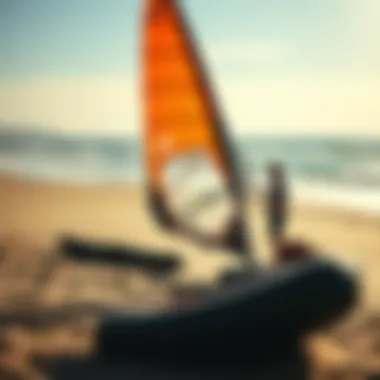
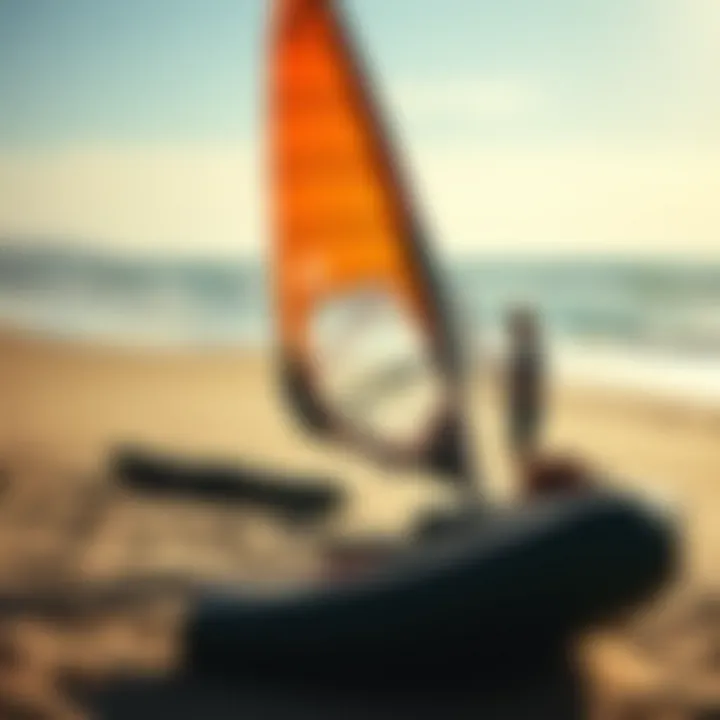
Intro
Inflatable wing foiling is catching fire in the water sports community. It combines elements of windsurfing and kitesurfing into one exciting experience that draws water enthusiasts from all walks of life. The beauty of this sport lies not only in its thrilling rides but also in the intricate equipment and techniques that make it all possible. In this article, we will delve deep into various facets of inflatable wing foiling—covering essential gear, effective techniques, and valuable insights gathered from seasoned riders.
This lively sport allows riders to harness the wind's power while gliding over water, providing a unique sense of freedom. Whether you're just dipping your toes into wing foiling or you're a seasoned kiteboarder looking to switch gears, understanding the dynamics of inflatable wing foiling can take your skills to new heights. So let's dive in!
Equipment Insights
Latest Gear Reviews
When considering inflatable wing foiling, the right gear makes all the difference. Here’s a closer look at some of the standout equipment that has been making waves in the market:
- Slingshot SlingWing V3: This wing boasts an improved canopy design for better stability at high speeds. Users have reported smoother flying, making it an excellent choice for both beginners and pros.
- Naish S25 Wing Surfer: Renowned for its lightweight build, the Naish wing also features a robust frame, ensuring durability. Riders appreciate the balanced control it offers during maneuvers.
- Duotone Echo: With exceptional handling in varying wind conditions, this wing has quickly become a crowd favorite. Riders have noted how responsive it feels when making quick turns.
As with any outdoor sport, choosing the right gear involves personal preference and conditions. Always try out equipment if you can, or look into rental options first.
Essential Gear Maintenance
Maintaining your gear is vital to ensuring longevity and performance. Here are some tips to keep everything in tip-top shape:
- Regular Inspections: Always check your wing for any tears or abrasions before hitting the water. Minor damages can lead to significant problems later.
- Cleaning: After a day on the water, rinse your gear with fresh water to remove salt and debris. This helps prevent corrosion and material degradation.
- Storage: Store your wing in a cool, dry place. Avoid leaving it out in direct sunlight for extended periods as UV rays can weaken the fabric.
"A stitch in time saves nine." - This old saying rings true in gear maintenance. Taking small steps can help avoid potential disasters on the water.
Technique Exploration
Beginner Techniques
For novices, mastering the basics is key to enjoying inflatable wing foiling. Here are a few techniques to get you started:
- Body Position: Maintain an upright position with knees slightly bent. This stance allows for better balance and responsiveness to wind changes.
- Wing Handling: Learning how to control the wing is crucial. Practice with a smaller wing first, and focus on maneuvering while standing still on the board.
- Water Starts: Begin by focusing on balancing the wing and your body weight. The goal is to smoothly transition from a stationary position to gliding on the water.
Advanced Maneuvers
Once you feel comfortable, it's time to spice things up with some advanced techniques:
- Tacks and Jibes: These are fundamental maneuvers for changing direction. They require precise timing and weight distribution, so practice them until they're second nature.
- Jumping: This is where the thrill really kicks in. Proper jump technique involves timing your board’s lift with the wind’s force. It's a delicate balance that takes time to perfect.
- Downwind Runs: For those who want to cover more distance, practicing downwind runs can add variety to your session. It tests your steering and speed control.
Engaging with online communities or local groups can also provide additional insights and tips tailored to your skill level. Websites like reddit.com/r/WingFoiling can offer unique perspectives and shared experiences.
The End
Inflatable wing foiling is not just a sport; it's an adventure waiting to be discovered. As you embark on this journey, remember equipment quality and technique mastery are the foundation of a safe and enjoyable experience. Equip yourself with the right tools, practice thoroughly, and connect with the community. With patience and persistence, you'll find yourself gliding across the waves with confidence and exhilaration.
For additional information on inflatable wing foiling, you can explore resources like Britannica and various instructional content available on platforms like YouTube. Embrace the wind and the water—it’s a journey worth taking!
Prologue to Inflatable Wing Foiling
Inflatable wing foiling is a captivating sport that blends the technical aspects of wind sports with the thrill of buoyancy, marking a significant milestone in water-related activities. This introduction delves into the essence of inflatable wing foiling, which not only showcases exhilarating maneuvers and fluid dynamics but also presents a platform for exploring the vast water landscapes. For both newcomers and seasoned enthusiasts, grasping the fundamentals of this sport is essential for attaining proficiency and enjoying the ride.
Understanding the Concept
So, what exactly is inflatable wing foiling? In its simplest terms, it is a water sport that consists of riding on a board while holding onto a wing, which harnesses wind power to propel the rider across the water. Unlike traditional windsurfing or kiteboarding, where riders rely on sails or kites, the inflatable wing provides a more user-friendly experience. Its buoyancy allows foilers to lift off the water, creating a sensation that's often described as flying.
The allure of inflatable wing foiling lies in its accessibility. Riders of all skill levels can quickly learn the ropes, making it an appealing choice for those who may find the complexity of other water sports overwhelming. By allowing users to enjoy smooth rides on various water surfaces, inflatable wing foiling caters to a wide audience, from casual beach-goers to thrill-seeking adventurers. This sport promises a more liberating experience that maintains essential safety features.
Historical Context
The journey of inflatable wing foiling is rooted in a confluence of various water sports, which have evolved over the decades. The concept originated as an experimental endeavor among enthusiasts who sought to combine elements from kiteboarding and windsurfing. While the exact timeline is a bit muddled, it gained traction in the early 2010s, with innovations in material technology and design playing pivotal roles.
Kiteboarding set a solid foundation for inflatable wings due to the prevalent use of inflatable kites. Riders began to realize that a smaller, inflatable wing could harness wind similarly while providing more maneuverability and stability. This insight led to the development of specialized wings, designed specifically for foiling. As equipment became lighter, more robust, and easier to control, the community witnessed an influx of new users eager to take to the water and experience the thrill of flight.
The popularity of inflatable wing foiling has since skyrocketed, with companies producing a range of designs to cater to diverse riding styles and environmental conditions. Brands have flooded the market, striving to enhance performance while prioritizing user comfort and safety. Today, inflatable wing foiling stands not only as a testament to innovation in water sports but also as a gathering point for a global community of riders.
"Inflatable wing foiling symbolizes the cutting edge of water sports, blending adventure with the joys of community participation - the water beckons to be explored."
As this sport continues to evolve, understanding its roots becomes essential to appreciate its current dynamics and future trends. Knowledge of its historical developments offers valuable insights into why inflatable wing foiling has taken the water sports world by storm.
Components of Inflatable Wing Foils
Understanding the components of inflatable wing foils is essential for anyone interested in this invigorating sport. Each element contributes uniquely to your overall experience on the water. Whether you’re a seasoned kiteboarder or just dipping your toes into wing foiling, knowing how these parts work can make all the difference. The interplay between the wing, board, and foil system not only affects performance but also your safety and enjoyment.
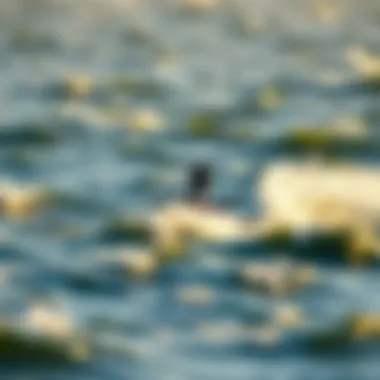

The Wing
The wing is the heart of inflatable wing foiling, acting as the primary source of lift and control. Generally designed with a flexible frame wrapped in durable material, wings come in various sizes and shapes, influencing how they perform in different wind conditions.
- Size Matters: Choosing the right size wing is crucial. A larger wing catches more wind, offering stability and lift at lower speeds, which is particularly beneficial for beginners. Conversely, more experienced riders may prefer smaller wings for agility and speed.
- Material and Design: Considerations such as the material used in construction and the design shape can significantly impact your ride. The fabric has to be lightweight yet durable enough to withstand abrasions. Reinforced seams prevent tearing during rough conditions, making specific wings more reliable than others.
- Control: How you handle the wing directly correlates to your overall maneuverability. Learning to balance the wing can take time but is vital for mastering transitions and turns.
"A well-balanced wing is like having an extra set of hands. It assists, guides, and lets you focus on the ride."
The Board
The board works in tandem with the wing, allowing riders to harness the wind's power efficiently. Boards come in various shapes and sizes as well, catering to different riding styles and conditions.
- Types of Boards: There are mainly two types: wakestyle and freestyle. Wakestyle boards are typically shorter and thicker, offering stability, while freestyle boards are longer and narrower, designed for advanced tricks.
- Foot Straps and Pads: Foot straps provide a secure connection to the board, enabling quicker reactions, especially during jumps or waves. The pads should be comfortable while allowing you to move quickly. Riders often have varying preferences on strap tension and placement.
- Hull Design: The contours of the board affect how it glides. A narrower hull means better speed, but stability might suffer unless the rider is adept at balancing. While for beginners, a wider base can provide a stable platform.
The Foil System
The foil system comprises the mast, fuselage, and wings. Together, they lift the board above the water’s surface, transforming your ride into something near ethereal.
- Components of the Foil: The mast connects the board to the foil wings. Selecting a mast of appropriate length is vital—shorter masts offer better control while longer ones can lift you up higher but require more skill to manage.
- Wings Configuration: Both the front and back wings work together, affecting lift and drag. Front wings are typically larger, providing lift, while back wings are smaller for stability and control during maneuvers. Riders often experiment with different wing configurations to find what complements their riding style.
- Adjustability: Many foils come with adjustable components, allowing riders to change angles to accommodate various conditions. Experimentation is key—what works on a flat day may not be suitable for windy conditions.
In summary, the components of inflatable wing foils function not just independently but also collaboratively, influencing the performance and experience of each rider. Knowing the ins and outs of these parts helps in making informed decisions when purchasing gear and improves your overall execution once on the water. For more information, consider checking resources such as Wikipedia or forums like Reddit.
Choosing the Right Equipment
Choosing suitable equipment is crucial in inflatable wing foiling, as it can greatly influence your riding experience. This sport, while immensely enjoyable, requires the right gear to harness the wind effectively and maintain stability on the water. Selecting the appropriate wing, board, and foil can make a world of difference, whether you are just starting or have years of experience under your belt. The right setup will enhance your performance, allow smoother transitions, and boost your overall confidence.
Factors to Consider
When diving into the world of inflatable wing foiling, several elements should guide your selections:
- Skill Level: Novices may want to opt for more stable and forgiving boards that provide easier balance. On the flip side, advanced riders might prefer stiffer boards for enhanced responsiveness and performance.
- Wind Conditions: Understanding the typical wind conditions in your area is vital. Some wings perform better in lighter winds, while others excel when breezes pick up. Adaptability to local conditions can save you from frustration on the water.
- Personal Preference: Shape, size, and color can all play into equipment choice. Some riders favor larger wings for easier lift, while others may opt for smaller, more agile options for tricks and maneuvers.
- Budget: Quality gear can be an investment. While it's tempting to go for the most expensive, effective shopping for budget-friendly gear that meets your needs can yield great results. Sometimes resale markets provide a chance to score good equipment without breaking the bank.
By assessing these factors, you'll prioritize what is essential for your unique wing foiling journey, ensuring that your gear complements your individual style.
Popular Brands and Models
Venturing into the inflatable wing foiling realm means you'll encounter various reputable brands that offer innovative models tailored to different styles and preferences. Some notable names include:
- Duotone: Known for their precision engineering and focus on performance, Duotone wings are a favorite among serious riders. Models like the Duotone Echo cater well to various conditions while maintaining excellent control.
- Naish: A staple in the water sports industry, Naish’s wings like the Naish S25 are celebrated for their stability and versatile designs. Beginners and seasoned riders alike appreciate their reliability.
- Flysurfer: Famed for quality and innovation, Flysurfer's wings, such as the Flysurfer Sonic, offer unique characteristics that appeal to both high-speed enthusiasts and casual riders.
- Slingshot: With a commitment to performance, Slingshot’s offering remains popular, with the Slingshot Wizard receiving praise for its balance and ease of use.
Beyond the established brands, always keep an ear to the ground for emerging companies. Newcomers often introduce cutting-edge designs that could surprise you with efficiency and performance. Keeping up with forums on reddit.com or social media groups on facebook.com can help highlight these fresh entries.
Techniques for Inflatable Wing Foiling
Understanding the right techniques is pivotal in inflatable wing foiling, as they influence a rider's overall experience and capability on the water. Mastering these techniques not only enhances performance but also boosts safety. With the right maneuvering skills, a rider can tackle various conditions, make sharper turns, and increase speed. It's this blend of skill and finesse that transforms wing foiling from a recreational activity into a thrilling pursuit.
Basic Maneuvers
Starting with the basics can set a solid foundation for anyone venturing into the world of inflatable wing foiling. Here are a few essential maneuvers that every beginner should focus on:
- The Start: Get the hang of launching off the board. Stand with feet shoulder width on the board, anchor the wing into the wind, and push off. A solid start is crucial for steady windsurfing.
- Tacking: This is about turning your board in the opposite direction. Keep your weight centered as you shift the wing across your body. This simple maneuver helps in improving direction and balance.
- Gybing: Similar to tacking, gybing requires smooth transitions while turning downwind. The wing should follow your motion without dropping too low. Having a good grip on gybing enables sharper turns, vital for maneuvering in tight spots.
"Once you get comfortable with these basic maneuvers, the thrill of pure wing foiling becomes evident. Nothing beats gliding above water with the wind as your companion."
- Basic Speed Control: Learning to sheet in and out will help manage speed. Pulling in the wing increases speed, while angling it out will help slow down. Finding that sweet spot comes with practice.
Consistent practice of these fundamental moves can accelerate one's progression in the sport, making challenging situations more approachable.
Advanced Techniques
As riders grow in confidence and skill, it’s time to tackle more advanced techniques. These not only elevate the sport but also enhance the rider's enjoyment and thrill factor. Here are some advanced techniques worth exploring:
- Jumping: This involves catching the wind and lifting off the water. Start with controlled speed, crouch slightly, and then pop off your heels. Timing the wing's lift with your jump adds an exhilarating dimension.
- Downwind Gliding: Mastering downwind gliding allows for maintaining optimal speed with minimal effort. Angle your board and wing correctly to harness the wind's power without excessive paddling.
- Freestyle Tricks: As you step into the realm of freestyle, moves like spins and flips can become a part of your repertoire. It requires precision and a confident feel for your board and wing.
- Sailing Upwind: This skill can be a game-changer; it involves understanding currents and angles. Practice different off-wind angles to find the path that allows your board to point more into the wind.
- Foil Control Tricks: Learning to control the foil will help in making smaller corrections while riding. It’s all about shifting your body weight subtly to adjust height and position.
Each of these advanced maneuvers demands a significant commitment to practice and understanding. Riders are encouraged to engage with the broader community through resources such as reddit.com/r/wingsurf and instructional tutorials on platforms like youtube.com to continuously refine their skills.
Mastering inflatable wing foiling techniques is a journey filled with challenges and rewards. With enough perseverance, the waves will sing your praises as you glide through the water.
Safety Considerations
When it comes to inflatable wing foiling, safety is not just a suggestion; it’s the golden rule. As exhilarating as this sport is, understanding the various safety considerations can mean the difference between an adrenaline rush and a harrowing experience. Riders venturing onto the water need to prioritize their safety and the well-being of those around them. By understanding equipment safety and establishing proper water safety protocols, individuals can enjoy the thrill while minimizing risks.
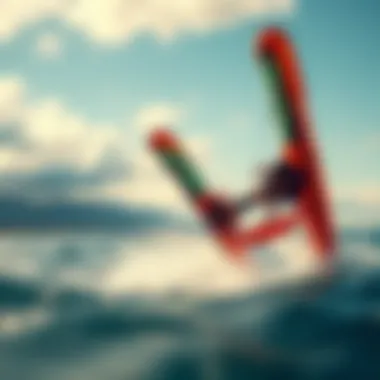
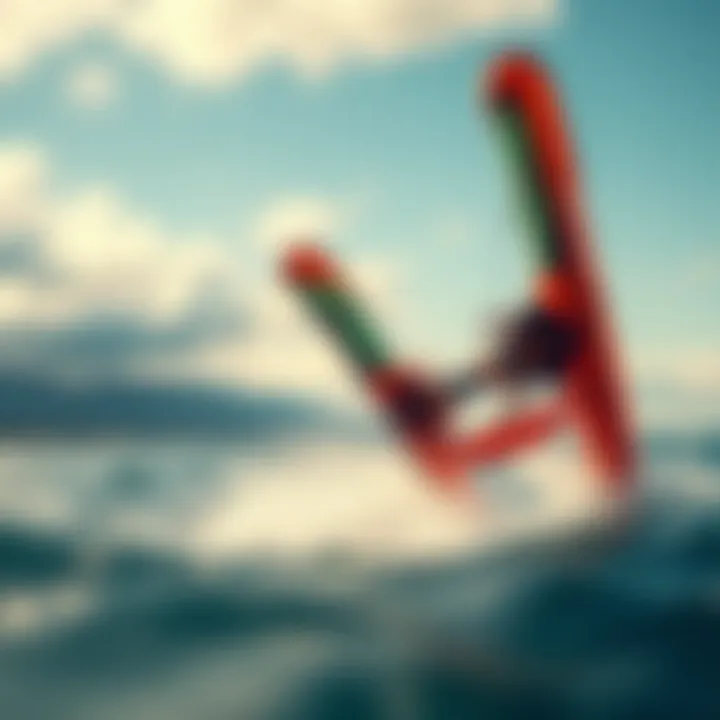
Equipment Safety
The first line of defense in wing foiling safety is properly maintaining and selecting your equipment. Riders should invariably check their inflatable wing, board, and foil for any wear and tear before heading out. Inflatable wings, for example, deflate unexpectedly if punctured, which can lead to serious loss of control. A simple visual inspection can be invaluable.
- Inflation Checks: Ensure the wing is fully inflated, as even a small loss of air can significantly affect performance.
- Board Integrity: Look for any dings or soft spots in the board. They could compromise buoyancy and stability.
- Safety Leashes: These are often overlooked. A reliable safety leash will make sure that you stay connected to your gear, especially during a fall.
Remember, just because something seems fine doesn’t mean it is, so be thorough in your checks. As the saying goes, "An ounce of prevention is worth a pound of cure."
Another key aspect of equipment safety is proper storage. Extreme temperatures—both hot and cold—can damage your equipment. It’s wise to store your gear indoors, away from direct sunlight and adverse weather conditions, ensuring your gear stays in tip-top shape for your next outing.
Water Safety Protocols
Once you've secured your equipment, the next step is adhering to essential water safety protocols. Various factors can affect safety, like weather conditions, water currents, and local regulations, making this knowledge crucial.
- Weather Awareness: Always check forecasts before hitting the water. Sudden gusts or storms can turn a pleasant setting into a treacherous one quick as a hiccup.
- Know Your Limits: If conditions are beyond your comfort zone, don’t hesitate to sit out. There’s nobility in knowing when to call it a day.
- Buddy System: It’s often wiser to ride alongside a friend rather than alone, as someone can assist or call for help if need be.
- Use of Buoyancy Aids: Wearing a personal flotation device can serve as a lifeline, especially in unpredictable aquatic environments. No need to swim; it can keep you afloat until rescue arrives.
"Safety is not a gadget but a state of mind."
– Eleanor Everet
Oftentimes, local waterways have specific regulations regarding safety. Familiarizing yourself with these guidelines is essential. They might dictate necessary equipment like helmets or life jackets, or provide insight into the best times to ride.
Through awareness and participation in proper safety practices, inflatable wing foiling can offer a safe yet exciting adventure. Always keep safety as your top priority, and enjoy every moment on the water.
Learning Resources and Communities
In the realm of inflatable wing foiling, having access to quality learning resources and active communities is paramount. The sport, still in its early stages, benefits greatly from shared knowledge and collective experiences. Engaging with both instructional courses and online forums can not only enhance a rider's skills but also foster connections with other enthusiasts, leading to a richer, more informed approach to wing foiling.
Instructional Courses
Instructional courses provide structured learning paths for both newcomers and seasoned riders aiming to refine their skills. Many reputable schools and instructors specialize specifically in wing foiling. These courses typically cover everything from the fundamentals of using a wing and board, to nuanced techniques for tackling winds and water conditions.
When selecting a course, consider the following:
- Certification and Experience: Ensure that the instructor has proper certification and experience in wing foiling.
- Course Structure: A well-rounded course will cover safety protocols, equipment handling, and practical riding sessions. Look for programs that offer hands-on experience on the water.
- Elevation of Skills: Advanced courses can help those with prior kiteboarding or windsurfing experience transition smoothly into wing foiling.
You might also want to check out resources like the International Kiteboarding Organization (IKO) which provides comprehensive education materials and training certifications relevant to wing foiling.
Online Communities and Forums
Online forums and communities serve as digital hubs for information exchange and camaraderie among riders. Websites like Reddit and various Facebook groups are teeming with individuals sharing tips, experiences, and the latest developments in the sport. Here are few benefits of engaging in these communities:
- Knowledge Sharing: Riders from around the world share their insights, whether it’s about new gear, safety tips, or the best local spots to ride.
- Problem Solving: Many enthusiasts encounter similar challenges. By discussing these issues in a communal space, you can benefit from collective wisdom.
- Event Updates: Communities often provide information about local events and competitions, encouraging participation and engagement in the sport.
Joining online forums not only enhances your own riding skills but also builds a sense of belonging in a passionate community.
Participate in discussions and don’t hesitate to ask questions. A simple post can lead to valuable advice from experienced riders, ultimately making your wing foiling journey more enjoyable and informed.
As the sport continues to evolve, embracing both structured instructional courses and interactive online communities will prove invaluable for any aspiring or dedicated inflatable wing foiler.
Environmental Impact of Wing Foiling
Wing foiling, while a burgeoning sport, also brings with it an irresistible curiosity about its environmental consequences. This segment delves into the nuanced interplay between this thrilling water activity and sustainability, illustrating how enthusiasts and manufacturers alike can sail the waves without leaving a detrimental mark on our oceans. Understanding the environmental impact of wing foiling is crucial not just for the passionate rider but for all stakeholders involved in marine and aquatic environments.
Sustainability in Equipment Manufacturing
When it comes to inflatable wing foiling, sustainability starts right at the drawing board. The materials used in manufacturing equipment play a vital role. Traditionally, the production of inflatable wings and foils often relied on synthetic materials that could be harmful after their life cycle ends. However, many forward-thinking brands are now pivoting towards more sustainable practices.
- Eco-friendly materials: Some companies now utilize recycled plastics or plant-based materials, reducing their carbon footprint.
- Longevity over disposability: Advances in design focus on durability, which lessens the need for replacements. This can decrease the overall waste generated by enthusiasts.
Implementing these sustainable practices serves a dual purpose: it not only caters to the eco-conscious consumer but also sets a precedent for future generations of water sports enthusiasts. As the mantra goes, “Take care of the earth, and it will take care of you.”
Impact on Marine Ecosystems
Wing foiling, if not practiced responsibly, poses a risk to marine ecosystems. The potential consequences can range from the physical impact on sea life to broader changes in biodiversity.
- Wildlife disturbance: As riders glide over the waters, they might inadvertently disrupt local wildlife. Seabirds, for example, are known to flee from disturbances.
- Erosion concerns: Heavy usage of certain spots, particularly during peak seasons, raises concerns of erosion along coastal areas. This can lead to habitat loss for various marine organisms, disrupting their natural cycles.
- Pollution: Not all wing foiling setups are free from plastic components; thus, improper disposal of broken gear can lead to pollution, particularly in delicate marine environments.
To mitigate these risks, communities engaging in wing foiling often advocate for responsible riding practices, promoting awareness about local wildlife and the importance of choosing less sensitive areas for launching and riding.
Ultimately, the goal is to create a symbiotic relationship between an exhilarating sport and the marine environment that inspires it.
In summary, while inflatable wing foiling embodies freedom on the open water, it also demands a degree of responsibility. By prioritizing sustainability in manufacturing and being conscious of our impact on marine ecosystems, we can enjoy the waves without compromising the health of our oceans. As awareness grows, so too can the community's commitment to a more sustainable approach in this exhilarating sport.
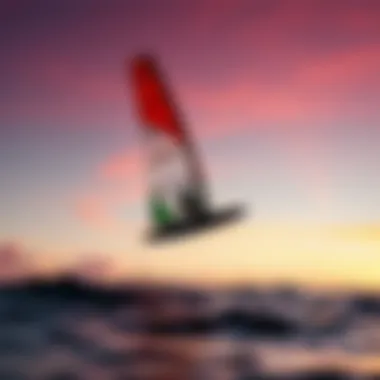
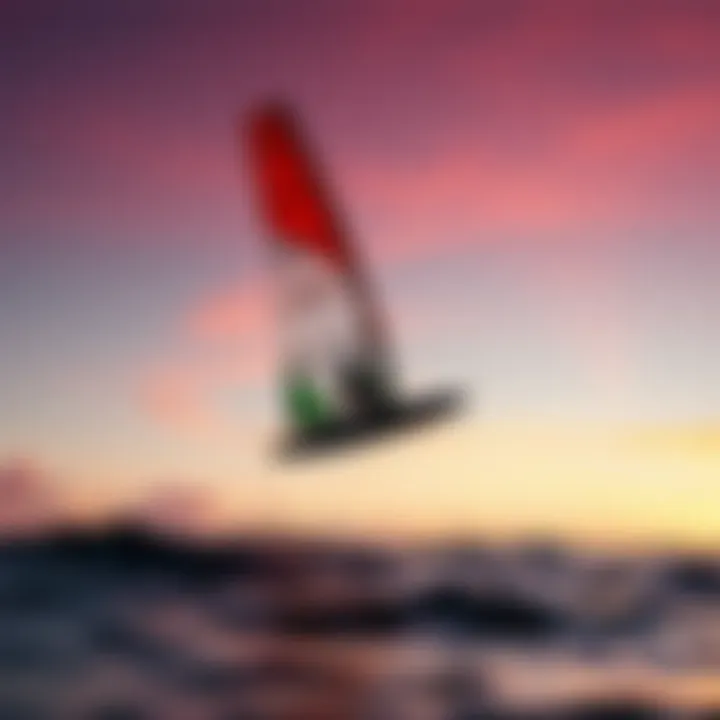
Comparative Analysis with Other Water Sports
Delving into the comparative analysis of inflatable wing foiling with other water sports is not just a matter of curiosity—it's an exploration of choices, styles, and community. By examining how inflatable wing foiling stacks up against its counterparts like kiteboarding and windsurfing, enthusiasts can better understand which sport might align with their preferences and skill levels. Each sport offers unique thrills and challenges, making this comparison essential for both seasoned participants and newcomers evaluating their options.
Differences and Similarities with Kiteboarding
Kiteboarding and inflatable wing foiling are often mentioned in the same breath, but they invite different experiences on the water. One of the primary distinctions lies in the method of propulsion. Kiteboarding relies on a large, fixed kite that is tethered to the rider, who maneuvers on a board beneath it. Meanwhile, wing foiling allows riders to harness the power of a handheld wing that can be maneuvered freely, providing an element of control that is distinct.
- Portability: Wing foiling gear is usually lighter, making it easier to transport. Kite gear can necessitate more substantial setups and can feel more cumbersome.
- Learning Curve: Many riders find that getting started in wing foiling can be less daunting since the wing can be held with one hand, allowing riders to maintain balance on the board while experimenting with the wing’s angle and the wind direction.
- Ocean Conditions: In terms of maneuverability, the inflatable wing tends to shine in varied wind and water conditions compared to kiteboarding. Riders can take full advantage of lighter winds without the need for extensive setup.
"Inflatable wing foiling might just be the easier entry point for those who find kiteboarding gear complicated. It combines some elements of traditional surfing while providing an innovative twist that captures the wind."
Both sports share the thrill of riding on water and the excitement of feeling the wind and waves beneath them, yet they cultivate different techniques and styles of riding.
Inflatable Wing Foiling vs. Windsurfing
When juxtaposing inflatable wing foiling with windsurfing, the difference becomes apparent in technique and equipment design. Windsurfing involves a fixed sail that’s attached to a board, which can seem like a rigid setup compared to the dynamic nature of wing foiling.
- Flexibility: With an inflatable wing, riders have a greater range of motion. The ability to lift and shift the wing directionally can feel more intuitive, allowing for freestyle moves and tricks that may not be as accessible in windsurfing, where the sail's position is primarily fixed.
- Learning Aspects: For beginners, the learning curve in windsurfing can feel steeper. Newcomers often find themselves wrestling with the sail positioning and board balance. Wing foiling, on the other hand, often enables smoother transitions into riding, making it easier to find one’s footing without extensive prior knowledge.
- Community and Accessibility: Both sports have strong communities, but many riders switch from windsurfing to inflatable wing foiling for its modern appeal and accessibility. This shift often brings fresh energy into the sport, as the contemporary gear complements simpler wind and water conditions.
As a sport that harmonizes traditional elements with modern technology, inflatable wing foiling can cater to a diverse array of riding styles. The more one understands these comparisons, the easier it becomes to appreciate what each water sport uniquely offers.
Personal Experiences from Riders
Understanding the journey of riders is crucial in exploring inflatable wing foiling. Their stories offer a treasure trove of insights, revealing top tips, challenges faced, and triumphs celebrated. Personal experiences from riders not only serve as inspiration for newcomers but also provide seasoned enthusiasts with fresh perspectives and strategies to enhance their skills.
Beginner Stories
Beginners in inflatable wing foiling often face a mix of excitement and trepidation when starting out. Many recount their feelings of overwhelming joy mingled with nervous anticipation, akin to jumping into a deep pool for the first time. One rider, Jane, described her initial experience: "I was scared at first, but once I caught my first gust of wind, it was like flying!"
These stories often include practical advice on equipment choice and skill development. For instance, a few riders suggest starting with smaller wings designed for ease of handling. This not only helps in gaining confidence but also minimizes the chances of an awkward tumble into the water. Moreover, the importance of learning to balance on the board before attempting to foil cannot be emphasized enough. Newcomers are encouraged to practice on flat water, which allows for safe experimentation with the wing and board dynamics drastically reducing the learning curve.
- Key Takeaways from Beginners:
- Start small: Begin with a manageable wing size.
- Practice balance: Work on standing stable on the board before progressing.
- Use flat water: It’s easier to learn without waves complicating things.
Success stories often point towards the sense of community found among riders. Online groups and local clubs become places of support. Many share their early mishaps, like Chris who humorously recalls, "I had more face plants than a toddler learning to walk, but every fall just made me want it more!" This resilience builds not only skills but also friendships that last beyond the water.
Advanced Riders' Perspectives
Advanced riders offer a wealth of deeper knowledge and a unique viewpoint shaped by experience. Their tales are filled with technical insights, often comprised of strategies that can make or break a session. One expert, Mike, emphasizes the importance of "tuning the wing and board for different conditions to maximize performance; it's a bit like being a mechanic and a rider all at once." Advanced riders often explore various conditions and report on how changing the wing size or foil aspect ratios can lead to dramatically different experiences on the water.
Moreover, their reflections frequently touch on the evolution of the sport itself and the improvements in technology. As riders begin to experiment with new foil designs or wing materials, they often find that subtle adjustments lead to significant enhancements. Anecdotes about riding under varying wind conditions or experimenting with tricks highlight not only personal achievements but also provide guidance for others looking to push their limits.
- Insights from Advanced Riders:
- Experimentation is key: Don’t shy away from trying new gear setups.
- Know your environment: Adapt to wind and water conditions; it’s not one-size-fits-all.
- Continue learning: The sport is constantly evolving; be open-minded.
"Every rider's story adds a new brushstroke to the canvas of our sport. Each tale, no matter how small, contributes to the vibrant tapestry of wing foiling." - Anonymous Rider
For more insights and community support, check out resources like Reddit and Facebook.
Understanding the dynamics of inflatable wing foiling goes beyond equipment and techniques; it deeply resides in the narratives of those who ride, learn, and persist.
Future Trends in Inflatable Wing Foiling
The realm of inflatable wing foiling is witnessing rapid evolution, necessitating a closer look at the trends shaping its future. Recognizing these trends is crucial, not only for enthusiasts aiming to stay ahead of the curve but also for manufacturers looking to innovate. From technological improvements enhancing performance to growth patterns within the community, the influx of changes promises to bolster the sport's accessibility and appeal.
Technological Advancements
In recent years, technology has played a pivotal role in advancing inflatable wing foiling. One significant trend is the development of lightweight materials that increase durability without sacrificing performance. Carbon fiber composites and advanced drop-stitch materials are becoming common, allowing devices to maintain rigidity while reducing the overall weight, making it easier for riders, especially beginners, to manage the equipment.
Furthermore, the integration of smart technology into wings and boards is gaining traction. Manufacturers are exploring ways to embed sensors that can provide real-time data concerning speed, wind conditions, and rider performance. Imagine a wing that not only catches the wind but also adjusts its shape based on conditions—this could revolutionize how both new and seasoned riders engage with the sport.
"The fusion of technology with inflatable wing foiling is not just about performance; it's about redefining user experiences."
In addition, the propulsion systems themselves are under the microscope. Electric foiling, which involves motors that can drive the board independently of wind, is on the rise. While this may seem at odds with the traditional ethos of wing foiling, it opens the sport to a broader audience, including those still grappling with mastering the basics.
Market Growth and Trends
As more people flock to explore water sports, inflatable wing foiling finds itself amidst a surge in popularity. Statistics indicate that participation rates are increasing at an impressive clip. Factors driving this growth include the ease of learning compared to other board sports, the mobility of inflatable equipment, and an increasingly connected community sharing tips and experiences through platforms like Reddit and Facebook.
New markets are emerging, particularly in regions traditionally not known for wind sports. Countries with vast coastlines and favorable winds are witnessing a rise in local communities and businesses dedicated to the sport. This surge fosters competition among brands striving to capture market share, leading to more affordable options and improved technology for all riders.
In terms of demographics, the sport is attracting younger audiences. Social media plays a significant role, with visually appealing media showcasing the exhilarating aspects of wing foiling. Additionally, collaborations with influencers in the water sports domain are being pursued to create engaging content, drawing more attention to inflatable wing foiling.
A few key aspects of the market dynamics to consider include:
- Growth in online retail, making it easier to access high-quality equipment.
- Increasing sponsorship deals from brands that recognize the sport’s potential.
- Enhanced networking opportunities through events, competitions, and workshops.







